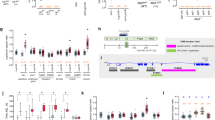Abstract
THE polarity of the surface folds on the abdominal cuticle of the insect Rhodnius which normally run at right angles to the antero-posterior axis, is controlled by the underlying epidermal cells. When portions of integument are transplanted or rotated the epidermal cells produce surface folds the orientation of which shows that the cells “remember”, at least to some extent, their original polarity1,2. Such experiments also suggest that the cells have access to information which defines the spatial pattern of differentiation within each segment3. It has been suggested that a gradient of some property exists which is reiterated from segment to segment so that the intersegmental border intervenes between the “high” part of one gradient and the “low” of the next. In one model the segmental gradient is viewed as a concentration gradient of a diffusible morphogen2–5. Studies in a closely related insect have shown that from a very early stage the segments have independent lineages, clones stopping abruptly at the intersegmental border5,6.
This is a preview of subscription content, access via your institution
Access options
Subscribe to this journal
Receive 51 print issues and online access
$199.00 per year
only $3.90 per issue
Buy this article
- Purchase on Springer Link
- Instant access to full article PDF
Prices may be subject to local taxes which are calculated during checkout
Similar content being viewed by others
References
Locke, M., J. exp. Biol., 36, 459 (1959).
Lawrence, P. A., Crick, F. H. C., and Munro, M., J. Cell. Sci, 11, 815 (1972).
Lawrence, P. A., Symp. Soc. exp. Biol., 25, 379 (1971).
Lawrence, P. A., J. exp. Biol., 44, 607 (1966).
Lawrence, P. A., Nature new Biol., 242, 31 (1973).
Lawrence, P. A., J. Embryol. exp. Morph. (in the press).
Furshpan, E. J., and Potter, D. D., Curr. Top. dev. Biol., 3, 98 (1968).
Goodwin, B. C., and Cohen, M. H., J. theor. Biol., 25, 49 (1969).
Loewenstein, W. R., 27th Symp. Soc. dev. Biol. (edit. by Locke, M.) (Academic Press, New York, 1969).
Dixon, J. S., and Cronly-Dillon, J. R., J. Embryol. exp. Morph., 28, 659 (1972).
Gilula, N. B., Reeves, O. R., and Steinbach, A., Nature, 235, 262 (1972).
Jones, B. M., and Cunningham, I., Exp. Cell Res., 23, 386 (1961).
Jahnke, E., and Emde, F., Tables of Functions with formulae and curves, 3rd ed. (Tuebner, Leipzig, Berlin, 1938).
Noble, D., Biophys. J., 2, 381 (1962).
Wigglesworth, V. B., Quart. Jl microsc. Sci., 76, 270 (1933).
Wigglesworth, V. B., J. exp. Biol., 21, 97 (1945).
Author information
Authors and Affiliations
Rights and permissions
About this article
Cite this article
WARNER, A., LAWRENCE, P. Electrical Coupling across Developmental Boundaries in Insect Epidermis. Nature 245, 47–48 (1973). https://doi.org/10.1038/245047a0
Received:
Issue Date:
DOI: https://doi.org/10.1038/245047a0
This article is cited by
-
Separation of developmental compartments by a cell type with reduced junctional permeability
Nature (1984)
-
Conductance and dye permeability of a rectifying electrical synapse
Nature (1983)
-
Pattern stability in the insect segment
Wilhelm Roux's Archives of Developmental Biology (1979)
-
Active ion transport by a sensory epithelium
Journal of Comparative Physiology ? A (1979)
Comments
By submitting a comment you agree to abide by our Terms and Community Guidelines. If you find something abusive or that does not comply with our terms or guidelines please flag it as inappropriate.



